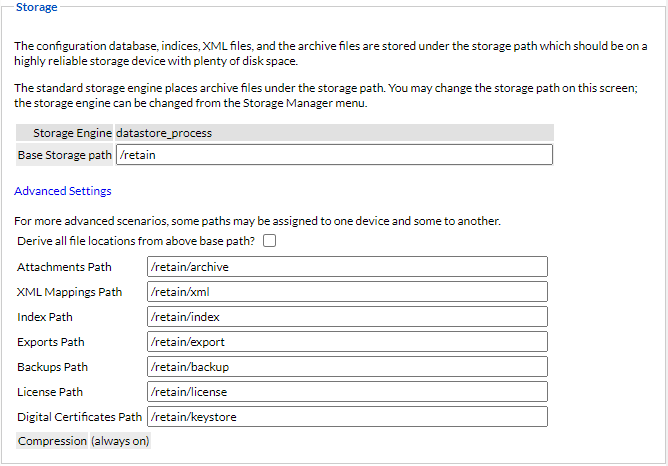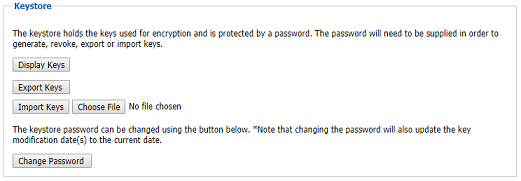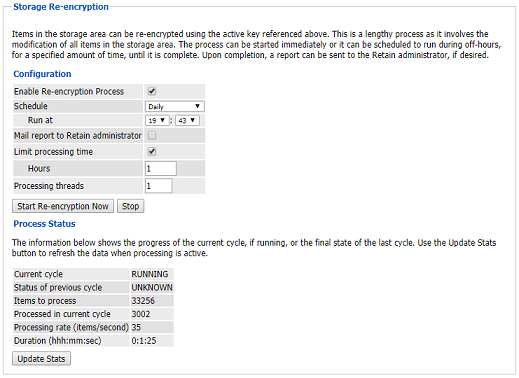2.3 Storage Tab

Use this tab to specify where the Retain archive files are stored and to manage encryption of archive BLOB files.
Path: Retain Server Manager > Configuration > Server Configuration > Storage Tab
The Storage tab contains the following panels:
2.3.1 Storage Panel

Path: Retain Server Manager > Configuration > Server Configuration > Storage Tab > Storage Panel
Table 2-8 Using the Storage Panel
|
Option, Field, or Sub-panel |
Information and/or Action |
|---|---|
|
Storage Engine |
Only informational. Configurable in the Storage Manager |
|
Base Storage Path |
Sets the default path for where the Retain archive, XML files, search index files, PDF exports, backups, and license files are stored. Customized paths for these can be set by clicking the Advanced Settings link and deselecting the Derive all file locations ... option. |
|
Advanced Settings |
Use this link to access customizable storage paths for the Retain archive, XML files, search index files, PDF exports, backups, and license files. Deselect the Derive all file locations ... option to display the list of paths. You can specify customized paths for the following:
|
|
Compression |
A reminder that compression is always used. |
2.3.2 Storage Encryption Panel

NOTE:Encryption is not currently supported on MS SQL databases.
Path: Retain Server Manager > Configuration > Server Configuration > Storage Tab > Storage Encryption Panel
Table 2-9 Using the Storage Encryption Panel
|
Option, Field, or Sub-panel |
Information and/or Action |
|---|---|
|
IMPORTANT:The following options, fields, etc. display only after you change the Storage Encryption option to aes. |
|
|
Storage Encryption option |
|
|
Key Status field |
|
|
Key Alias |
This is the system name that Retain assigned to the currently active encryption key. Keys are listed in the keystore using this system name (alias). |
|
Key Type |
The encryption type and level of the currently active encryption key. Retain generates new keys to the 256-bit Advanced Encryption Standard (AES 256). |
|
Generate Key button |
Clicking this causes Retain to generate a new AES 256 key and to begin encrypting the Retain archive files with that key. When generating the system’s first key, you must set and confirm a keystore password that
IMPORTANT:Make sure you don’t lose the keystore password. For generating subsequent keys, you need only enter the password once. |
|
Revoke Key button |
Clicking this and confirming the action, causes the encryption key to be revoked. Encryption of incoming archive items is suspended and the Key Status changes to Revoked. The revoked key is saved in the keystore so that Retain can decrypt any archive files that were encrypted with it. Revoked keys are only removed after all items that were previously encrypted by the revoked keys are re-encrypted by a new key through Retain’s Storage Re-encryption functionality. |
Keystore Sub-panel

Path: Retain Server Manager > Configuration > Server Configuration > Storage Tab > Storage Encryption Panel > Keystore Sub-panel
Table 2-10 Using the Keystore Sub-panel
|
Option, Field, or Sub-panel |
Information and/or Action |
|---|---|
|
Display Keys button |
Clicking this displays the names (key aliases) and modification dates of all keys in the keystore. To view the contents of an exported .jks file that is offline, use one of the following options. At a terminal prompt,
In a desktop GUI environment,
|
|
Export Keys button |
Clicking this and entering the keystore password causes the keystore to be exported as a .jks file named retainKeyStore.jks and downloaded to the browser’s default download location on the machine that is running the management browser. We recommend renaming this file to reflect its origin. For example, Retain-svr01-KeyStore.jks for a retain server named Retain-svr01. |
|
Import Keys button |
Before clicking this button, you must first browse to and choose a .jks file. After clicking this button, you must enter the keystore password for this Retain server and then the keystore password for the keystore on the server where the.jks file originated. |
|
Choose File button |
Click this button to browse to and select a .jks keystore file for importing. |
|
Change Password button |
Click this button to change the keystore password for this Retain server. |
Storage Re-encryption Sub-panel

Path: Retain Server Manager > Configuration > Server Configuration > Storage Tab > Storage Encryption Panel > Storage Re-encryption Sub-panel
Table 2-11 Using the Storage Re-encryption Sub-panel
|
Option, Field, or Sub-panel |
Information and/or Action |
|---|---|
|
Configuration Section: Use the following to manage and control the re-encryption process. |
|
|
Enable Re-encryption Process option |
Re-encryption only runs when this is enabled. |
|
Schedule drop-down list |
You can schedule re-encryption processes to run daily, weekly, or monthly. |
|
Run at option |
Specify when you want re-encryption processes to run in 24-hour time. |
|
Mail report to Retain administrator option |
If you have configured the system with SMTP services and the Retain administrator has an associated email account, enabling this causes Retain to email the administrator with status updates. |
|
Limit processing time option |
If you want to limit the length of time spent on re-encryption in each run cycle, enable this option. |
|
Hours field |
Specify the number of hours the system can spend on re-encryption in each run cycle. |
|
Processing threads option |
Specify the number of threads the system can devote to re-encryption processes. |
|
Start Re-encryption Now button |
Click this to circumvent the schedule and start re-encryption immediately. |
|
Stop button |
Click this to halt the current re-encryption process. |
|
Process Status Section: Informational fields for tracking re-encryption process status. |
|
|
Current cycle |
|
|
Status of previous cycle |
|
|
Items to process |
The total number of archived items that require re-encryption. |
|
Processed in current cycle |
The total number of items encrypted during the current cycle. |
|
Processing rate (items/second) |
The average number of items processed per second. |
|
Duration (hhh:mm:sec) |
How long the current cycle has been running. |
|
Update Stats button |
Click this to immediately update the statistics displayed above it. |